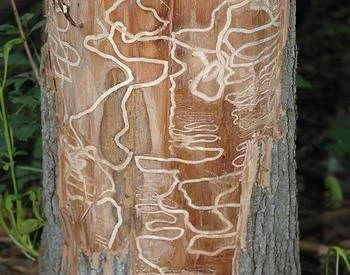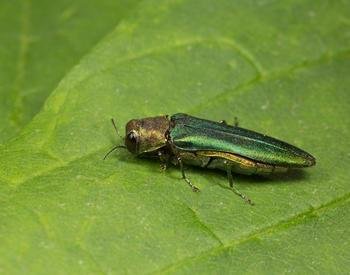Emerald Ash Borer Beetle,Credit: money cue_canada.adobe.com (Cropped from original)
From website: https://extension.oregonstate.edu/collection/emerald-ash-borer-resources
One component of our restoration work is to be aware of both current and potential future invasive species threats. These threats come in many forms; vegetative, mammal, fish, insects and more. Willamette Riverkeeper, along with every other natural resource agency and organization, has been dreading the arrival of one particular destructive pest, the emerald ash borer (EAB). Many of you may have heard about the ironic discovery of this insect earlier this summer by Dominic Maze, a biologist that focuses on invasive species. Talk about the right man, in the right place, at the right time. Dominic was in Forest Grove picking up his children from summer camp when he identified a certain beetle crawling on one of his kids after noticing an unhealthy stand of ash trees. This finding has shaken the natural resource field but has also prompted immediate action from agencies, organizations and the public to work together in a collaborative approach. We are all actively working on action plans, collecting data and information, as well as best practices to raise awareness without causing panic. What we do not want is for folks to worsen the situation by removing trees prematurely or using toxic insecticides that could cause larger harmful impacts in the present.
For those of you who might not be aware of the EAB, this is a non-native beetle and much of the East Coast has witnessed the devastation of entire stands of ash trees throughout their states. The Oregon ash (Fraxinus latifolia), and potentially two other susceptible species, olive (Olea europaea) and white fringetree (Chionanthus virginicus) are the tree species we are concerned about being impacted and/or hosts. For more information on EAB check out OSU extensions resources.
Our hope is to share a few actions and tips with y’all to help us with this fight.
- Please Don’t Move Firewood! “Buy it where you burn it”. This is one of the easiest ways to limit the rate of spread. This insect can fly but with its short 3-week adult life cycle, it cannot travel as far as person in a vehicle, truck or trailer. So please help stop new outbreaks!
- Learn how to identify this beetle, an ash tree, and the signs that tell if a tree is infected. EAB wears a metallic olive to green, solid color shield and is smaller than a penny, at 1/3 to 1/2 inch in length. Probably many of us have seen a metallic insect of sorts and had that dreadful feeling in our gut that it’s an emerald ash borer, so learning the look alike species is equally important to save the resources and time of folks who are actively working on valid sightings in their area.
- Pay attention and informed. Stay up to date with this pest’s distribution, as well as the appropriate actions to take. We definitely don’t want folks causing harm to trees that have not been affected yet or dispose of trees while not following the proper guidance tools. Please stay informed!
As you all know protecting the Willamette River is our life’s mission and ash trees make up a huge percentage of riparian vegetation. They also comprise a large percent of our urban and residential areas and they provide numerous benefits to our state, habitats, fish and wildlife. Our restoration team is taking any actions we can to help contain this, educate the public, and create future plans for a rapid response at our project sites if and sadly when, we need to remove trees. Please help us with this fight and utilize all the incredible resources and tools out there to learn more. If you have any questions, please reach out to our restoration team at [email protected] or your local WC or SWCD.
Written by Vanessa Youngblood, WR Restoration Coordinator





